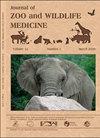Ivan I Castillo, Sudona Nelson, Karisa Tang, Shiyuan Deng, William Van Bonn, Matthew O'Connor, Kathryn C Gamble
求助PDF
{"title":"SPHENISCID ALPHAHERPESVIRUS 1 IN AFRICAN PENGUINS (<i>SPHENISCUS DEMERSUS</i>) WITHIN THE SPECIES SURVIVAL PLAN<sup>©</sup> MANAGED POPULATION IN THE US: INCIDENCE AND POPULATION IMPACT.","authors":"Ivan I Castillo, Sudona Nelson, Karisa Tang, Shiyuan Deng, William Van Bonn, Matthew O'Connor, Kathryn C Gamble","doi":"10.1638/2023-0116","DOIUrl":null,"url":null,"abstract":"<p><p>Spheniscid alphaherpesvirus-1 (SpAHV-1) is associated with respiratory disease in juvenile African penguins (<i>Spheniscus demersus</i>). In 2020, this virus was detected in adult birds with clinical signs of respiratory disease in a previously asymptomatic colony of 21 birds following a recommended introduction of three new birds, including two with a history of herpesvirus as juveniles. Mild to moderate respiratory signs were noted in 33% (8/24) of the colony. SpAHV-1 DNA was detected in respiratory secreta by herpesvirus consensus PCR in three birds, although as the definitive source of the presentation, it could not be confirmed. Surveillance for SpAHV-1 was performed in all colony birds seven and 19 mo following resolution of respiratory disease signs. SpAHV-1 was detected via consensus herpesvirus PCR and sequencing in two apparently healthy individuals, including one which had clinical signs of respiratory disease and tested positive for SpAHV-1 during the original outbreak. Due to limited knowledge about this pathogen, a retrospective assessment regarding SpAHV-1 and respiratory disease was performed by analyzing survey data collected from 41 institutions holding African penguins in the Species Survival Plan<sup>©</sup> (SSP) North American population from 2011-2021. From the 41 institutions that participated, 782 birds were evaluated and assessed, representing 70% of the total available population (n = 1,116). The majority (80%; 33/41) of participating institutions' veterinarians reported no knowledge of SpAHV-1 prior to this survey. Respiratory disease (e.g., sneezing, coughing, nasal discharge, oropharyngeal plaques, pulmonary auscultation changes) was reported in 21.2% of the surveyed cohort. Most clinical signs were resolved within 3-30 dy, with an average duration of illness of 13 dy. The odds of respiratory disease were significantly higher in males (<i>p</i> < 0.0001) and in non-transferred penguins as compared to those penguins transferred between institutions (<i>p</i> = 0.005). Only 5.6% of penguins (44/782) were tested for herpesviruses by PCR during the study period and of these birds, 18% (8/44) were positive for SpAHV-1. SpAHV-1 represents an important differential for respiratory disease in African penguins, but additional epidemiologic research is needed to determine the full impact of this pathogen.</p>","PeriodicalId":17667,"journal":{"name":"Journal of Zoo and Wildlife Medicine","volume":"56 1","pages":"89-95"},"PeriodicalIF":0.7000,"publicationDate":"2025-03-01","publicationTypes":"Journal Article","fieldsOfStudy":null,"isOpenAccess":false,"openAccessPdf":"","citationCount":"0","resultStr":null,"platform":"Semanticscholar","paperid":null,"PeriodicalName":"Journal of Zoo and Wildlife Medicine","FirstCategoryId":"97","ListUrlMain":"https://doi.org/10.1638/2023-0116","RegionNum":4,"RegionCategory":"农林科学","ArticlePicture":[],"TitleCN":null,"AbstractTextCN":null,"PMCID":null,"EPubDate":"","PubModel":"","JCR":"Q3","JCRName":"VETERINARY SCIENCES","Score":null,"Total":0}
引用次数: 0
引用
批量引用
Abstract
Spheniscid alphaherpesvirus-1 (SpAHV-1) is associated with respiratory disease in juvenile African penguins (Spheniscus demersus ). In 2020, this virus was detected in adult birds with clinical signs of respiratory disease in a previously asymptomatic colony of 21 birds following a recommended introduction of three new birds, including two with a history of herpesvirus as juveniles. Mild to moderate respiratory signs were noted in 33% (8/24) of the colony. SpAHV-1 DNA was detected in respiratory secreta by herpesvirus consensus PCR in three birds, although as the definitive source of the presentation, it could not be confirmed. Surveillance for SpAHV-1 was performed in all colony birds seven and 19 mo following resolution of respiratory disease signs. SpAHV-1 was detected via consensus herpesvirus PCR and sequencing in two apparently healthy individuals, including one which had clinical signs of respiratory disease and tested positive for SpAHV-1 during the original outbreak. Due to limited knowledge about this pathogen, a retrospective assessment regarding SpAHV-1 and respiratory disease was performed by analyzing survey data collected from 41 institutions holding African penguins in the Species Survival Plan© (SSP) North American population from 2011-2021. From the 41 institutions that participated, 782 birds were evaluated and assessed, representing 70% of the total available population (n = 1,116). The majority (80%; 33/41) of participating institutions' veterinarians reported no knowledge of SpAHV-1 prior to this survey. Respiratory disease (e.g., sneezing, coughing, nasal discharge, oropharyngeal plaques, pulmonary auscultation changes) was reported in 21.2% of the surveyed cohort. Most clinical signs were resolved within 3-30 dy, with an average duration of illness of 13 dy. The odds of respiratory disease were significantly higher in males (p < 0.0001) and in non-transferred penguins as compared to those penguins transferred between institutions (p = 0.005). Only 5.6% of penguins (44/782) were tested for herpesviruses by PCR during the study period and of these birds, 18% (8/44) were positive for SpAHV-1. SpAHV-1 represents an important differential for respiratory disease in African penguins, but additional epidemiologic research is needed to determine the full impact of this pathogen.
物种生存计划内非洲企鹅(spheniscus demersus)中的Spheniscid α疱疹病毒1©美国管理种群:发病率和种群影响。
Spheniscid alphaherpesvirus-1 (SpAHV-1)与幼年非洲企鹅(Spheniscus demersus)的呼吸道疾病有关。2020年,在一个以前无症状的21只鸟的群体中,在有呼吸道疾病临床症状的成年鸟中发现了这种病毒,此前建议引入3只新鸟,其中2只在幼年时有疱疹病毒史。33%(8/24)的患者出现轻至中度呼吸体征。SpAHV-1 DNA通过疱疹病毒共识聚合酶链反应在3只鸟类的呼吸道分泌物中检测到,尽管作为最终的呈现来源,它无法得到证实。在呼吸道疾病症状消退后7个月和19个月对所有种群鸟类进行SpAHV-1监测。通过共识疱疹病毒PCR和测序在两名明显健康的个体中检测到SpAHV-1,其中一人在最初的暴发期间有呼吸道疾病的临床症状并检测出SpAHV-1阳性。由于对该病原体的了解有限,通过分析2011-2021年在41个机构收集的物种生存计划©(SSP)北美种群中的非洲企鹅的调查数据,对SpAHV-1和呼吸道疾病进行了回顾性评估。在41个参与的机构中,对782只鸟类进行了评估和评估,占可用种群总数的70% (n = 1,116)。大多数(80%;33/41)参与调查机构的兽医报告在调查前不知道SpAHV-1。呼吸道疾病(如打喷嚏、咳嗽、流鼻涕、口咽斑块、肺部听诊改变)在被调查队列中占21.2%。大多数临床症状在3-30天内消失,平均病程为13天。雄性企鹅(p < 0.0001)和未转移的企鹅患呼吸道疾病的几率明显高于在不同机构之间转移的企鹅(p = 0.005)。在研究期间,仅有5.6%的企鹅(44/782)进行了疱疹病毒PCR检测,其中18%(8/44)为SpAHV-1阳性。SpAHV-1代表了非洲企鹅呼吸道疾病的一个重要差异,但需要进一步的流行病学研究来确定该病原体的全面影响。
本文章由计算机程序翻译,如有差异,请以英文原文为准。

 求助内容:
求助内容: 应助结果提醒方式:
应助结果提醒方式:


